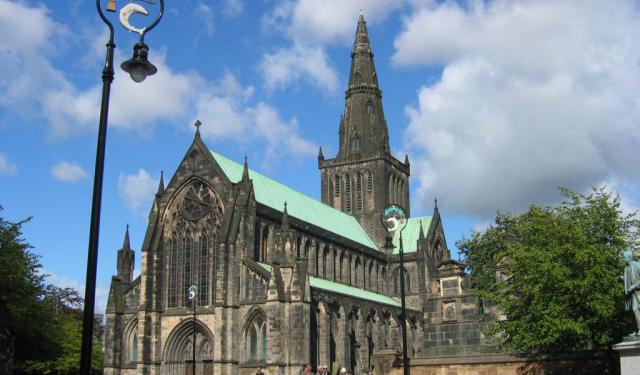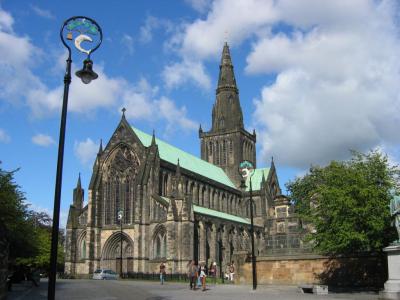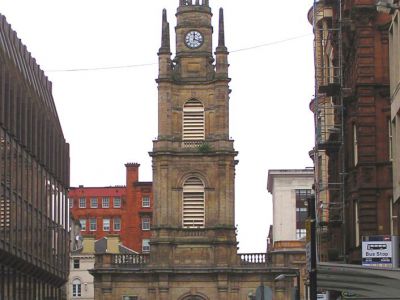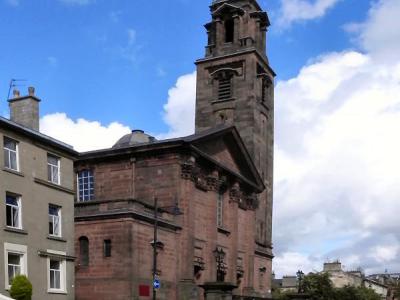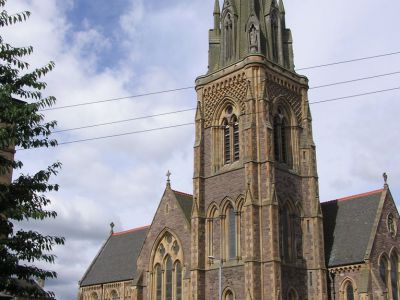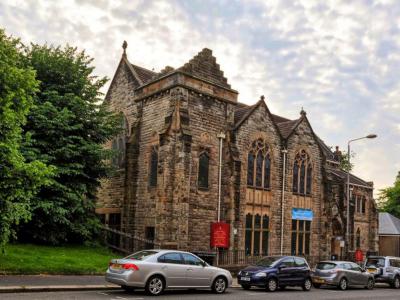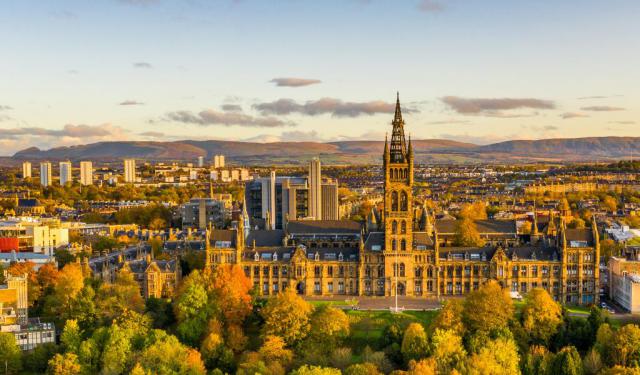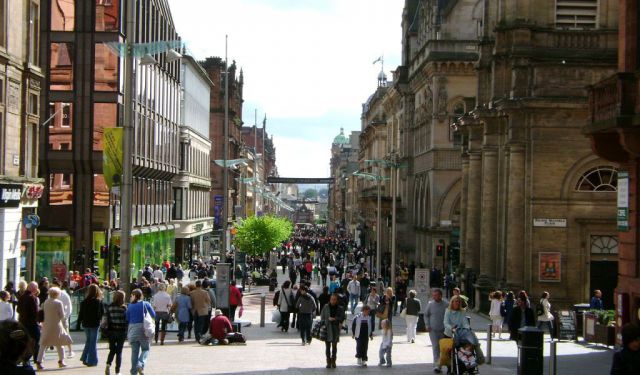Historical Churches (Self Guided), Glasgow
The feeling of serenity and being free from stress and worries is quite precious these days. And where better to find this than inside a church? Glasgow is home to a number of great churches that are notable for their architectural design, mostly in the Gothic style.
One of the city's most iconic ecclesiastical landmarks and a stunning example of Gothic architecture is Saint Mungo's Cathedral. Dating back to the 12th century, this house of worship, otherwise known as Glasgow Cathedral, is dedicated to Saint Mungo, Glasgow's patron saint.
Saint George's-Tron Church is another prominent religious site. This temple is renowned for its role in the city's history, having witnessed significant events and played a central role in Glasgow's religious life over the years.
Saint Aloysius' Church, an architectural gem with its elaborate Baroque style, is a testament to Glasgow's Catholic heritage. It showcases exquisite artistry both inside and out.
Saint Mary the Virgin Cathedral, commonly known as Glasgow's Episcopal Cathedral, is yet another splendid religious edifice of note. Its Neo-Gothic architecture and stunning stained glass windows draw visitors seeking spiritual solace and architectural marvels.
Finally, Woodland Methodist Church, a less grand but equally significant structure, has been a spiritual refuge for the community for many years. Its simple yet charming design reflects the diversity of faith in Glasgow.
The historical churches of Glasgow are more than just architectural wonders; they are living reminders of the city's past and the role that faith has played in shaping its identity. We therefore encourage you to explore these remarkable places of worship, each with its unique charm and significance, on your next trip to Glasgow to gain a deeper appreciation of the city's cultural heritage.
One of the city's most iconic ecclesiastical landmarks and a stunning example of Gothic architecture is Saint Mungo's Cathedral. Dating back to the 12th century, this house of worship, otherwise known as Glasgow Cathedral, is dedicated to Saint Mungo, Glasgow's patron saint.
Saint George's-Tron Church is another prominent religious site. This temple is renowned for its role in the city's history, having witnessed significant events and played a central role in Glasgow's religious life over the years.
Saint Aloysius' Church, an architectural gem with its elaborate Baroque style, is a testament to Glasgow's Catholic heritage. It showcases exquisite artistry both inside and out.
Saint Mary the Virgin Cathedral, commonly known as Glasgow's Episcopal Cathedral, is yet another splendid religious edifice of note. Its Neo-Gothic architecture and stunning stained glass windows draw visitors seeking spiritual solace and architectural marvels.
Finally, Woodland Methodist Church, a less grand but equally significant structure, has been a spiritual refuge for the community for many years. Its simple yet charming design reflects the diversity of faith in Glasgow.
The historical churches of Glasgow are more than just architectural wonders; they are living reminders of the city's past and the role that faith has played in shaping its identity. We therefore encourage you to explore these remarkable places of worship, each with its unique charm and significance, on your next trip to Glasgow to gain a deeper appreciation of the city's cultural heritage.
How it works: Download the app "GPSmyCity: Walks in 1K+ Cities" from Apple App Store or Google Play Store to your mobile phone or tablet. The app turns your mobile device into a personal tour guide and its built-in GPS navigation functions guide you from one tour stop to next. The app works offline, so no data plan is needed when traveling abroad.
Historical Churches Map
Guide Name: Historical Churches
Guide Location: Scotland » Glasgow (See other walking tours in Glasgow)
Guide Type: Self-guided Walking Tour (Sightseeing)
# of Attractions: 5
Tour Duration: 2 Hour(s)
Travel Distance: 4.1 Km or 2.5 Miles
Author: irenes
Sight(s) Featured in This Guide:
Guide Location: Scotland » Glasgow (See other walking tours in Glasgow)
Guide Type: Self-guided Walking Tour (Sightseeing)
# of Attractions: 5
Tour Duration: 2 Hour(s)
Travel Distance: 4.1 Km or 2.5 Miles
Author: irenes
Sight(s) Featured in This Guide:
- Saint Mungo's Cathedral
- Saint George's Tron Church
- Saint Aloysius' Church
- Saint Mary the Virgin Cathedral
- Woodland Methodist Church
1) Saint Mungo's Cathedral (must see)
Rising proudly over the city with its striking spire and darkened stone, Saint Mungo’s Cathedral-also known as Glasgow Cathedral or the High Kirk of Glasgow-is one of Scotland’s most remarkable medieval landmarks. Dedicated to the city’s patron saint, Saint Mungo (also called Saint Kentigern), it stands on the very spot where the saint is believed to have built his church in the 6th century. The present structure, begun in the 12th century, is the only mainland Scottish cathedral to have survived the Protestant Reformation intact, making it a rare and atmospheric link to the nation’s medieval past.
Step inside and you’ll find a vast interior filled with soaring stone arches, stained-glass windows that cast jewel-like colors across the nave, and centuries-old carvings that reward close attention. The cathedral’s crowning treasure is the Lower Church, a beautifully preserved medieval crypt that houses the shrine of Saint Mungo himself. This hushed, vaulted space is one of the most evocative sites in Glasgow, where pilgrims and visitors alike pause in quiet reflection.
The upper choir and nave showcase the craftsmanship of medieval masons, with intricately carved stone screens and elaborate vaulted ceilings. Many visitors are struck by the contrast between the building’s austere Gothic exterior and the light filtering through its stained glass, much of which was created in the 19th and 20th centuries, yet harmonizes seamlessly with the ancient fabric.
Surrounded by the atmospheric Glasgow Necropolis and the remains of the medieval hospital of the Bishop’s Castle, Saint Mungo’s Cathedral is more than a church-it is a living monument to Glasgow’s deep historical roots. Drawn by architecture, history, or the desire for quiet contemplation, a visit here reveals a glimpse of the city’s soul and its enduring faith.
Step inside and you’ll find a vast interior filled with soaring stone arches, stained-glass windows that cast jewel-like colors across the nave, and centuries-old carvings that reward close attention. The cathedral’s crowning treasure is the Lower Church, a beautifully preserved medieval crypt that houses the shrine of Saint Mungo himself. This hushed, vaulted space is one of the most evocative sites in Glasgow, where pilgrims and visitors alike pause in quiet reflection.
The upper choir and nave showcase the craftsmanship of medieval masons, with intricately carved stone screens and elaborate vaulted ceilings. Many visitors are struck by the contrast between the building’s austere Gothic exterior and the light filtering through its stained glass, much of which was created in the 19th and 20th centuries, yet harmonizes seamlessly with the ancient fabric.
Surrounded by the atmospheric Glasgow Necropolis and the remains of the medieval hospital of the Bishop’s Castle, Saint Mungo’s Cathedral is more than a church-it is a living monument to Glasgow’s deep historical roots. Drawn by architecture, history, or the desire for quiet contemplation, a visit here reveals a glimpse of the city’s soul and its enduring faith.
2) Saint George's Tron Church
Saint George’s Tron Church is one of Glasgow’s most recognisable landmarks, standing prominently at the junction of Buchanan Street and Nelson Mandela Place in the city centre. Completed in 1808, it was designed by the architect William Stark, whose neoclassical style gave the church a sense of grandeur and balance suited to its busy urban setting. Its tall steeple, rising to more than 160 feet, became a guiding point for Glaswegians moving through the heart of the city, and it remains a key feature of Glasgow’s skyline.
The church was built during a period when Glasgow was expanding rapidly due to trade and industry, and it reflected the city’s ambition to establish itself as a modern European metropolis. Over the years, Saint George’s Tron has been a site of community gatherings, worship, and civic events, adapting its role as the city around it changed. Its position at the top of Buchanan Street means that it has long been associated with the energy and commerce of central Glasgow, serving not just as a religious space but also as a civic landmark.
Today, Saint George’s Tron remains an active congregation of the Church of Scotland while also hosting a variety of cultural and social initiatives. Its interior, though modified over time, preserves elements of its early design while offering a welcoming space for visitors and worshippers alike. The church is also known for its outreach work and its place in the everyday life of the city, offering both quiet reflection and a sense of connection amidst the bustle of Glasgow’s busiest streets.
For visitors, the church offers a chance to step inside one of Glasgow’s historic religious buildings while enjoying its central location near shops, galleries, and public squares. Its blend of history, architecture, and community spirit makes it a worthwhile stop for anyone exploring the city centre.
The church was built during a period when Glasgow was expanding rapidly due to trade and industry, and it reflected the city’s ambition to establish itself as a modern European metropolis. Over the years, Saint George’s Tron has been a site of community gatherings, worship, and civic events, adapting its role as the city around it changed. Its position at the top of Buchanan Street means that it has long been associated with the energy and commerce of central Glasgow, serving not just as a religious space but also as a civic landmark.
Today, Saint George’s Tron remains an active congregation of the Church of Scotland while also hosting a variety of cultural and social initiatives. Its interior, though modified over time, preserves elements of its early design while offering a welcoming space for visitors and worshippers alike. The church is also known for its outreach work and its place in the everyday life of the city, offering both quiet reflection and a sense of connection amidst the bustle of Glasgow’s busiest streets.
For visitors, the church offers a chance to step inside one of Glasgow’s historic religious buildings while enjoying its central location near shops, galleries, and public squares. Its blend of history, architecture, and community spirit makes it a worthwhile stop for anyone exploring the city centre.
3) Saint Aloysius' Church
Saint Aloysius’ Church is one of Scotland’s most striking Roman Catholic churches, easily recognised by its towering spire that rises dramatically above Garnethill. Completed in 1910, it was designed by Belgian architect Charles Menart, who modelled the church on the grand Jesuit Church of the Sacred Heart in Brussels. Its dedication to Saint Aloysius Gonzaga, the 16th-century Jesuit patron saint of youth and students, reflects the strong Jesuit presence in the city. The church’s architecture, combining Baroque influences with Scottish stone craftsmanship, makes it an impressive landmark both for its religious role and artistic merit.
Inside, visitors are welcomed into an ornate sanctuary filled with intricate woodwork, stained glass, and marble altars. The interior was designed to create a sense of grandeur and contemplation, drawing the eye upward to its richly decorated ceilings and elegant arches. The side chapels, each adorned with devotional statues and detailed artwork, give an intimate sense of the parish’s deep traditions. A highlight is the church’s main altar and reredos, which echo the elaborate style of continental Jesuit churches while maintaining a distinctly Glaswegian character.
Saint Aloysius’ is not just an architectural gem but also a thriving centre of worship and community life. As one of the few Jesuit parishes in Scotland, it has long been associated with education, social outreach, and cultural life in Glasgow. Its proximity to the Glasgow School of Art and the city centre makes it a popular stop for visitors interested in both faith and history. Drawn by its soaring spire, intricate craftsmanship, or ongoing role in community life, Saint Aloysius’ Church provides a memorable glimpse into Glasgow’s spiritual and cultural heritage.
Inside, visitors are welcomed into an ornate sanctuary filled with intricate woodwork, stained glass, and marble altars. The interior was designed to create a sense of grandeur and contemplation, drawing the eye upward to its richly decorated ceilings and elegant arches. The side chapels, each adorned with devotional statues and detailed artwork, give an intimate sense of the parish’s deep traditions. A highlight is the church’s main altar and reredos, which echo the elaborate style of continental Jesuit churches while maintaining a distinctly Glaswegian character.
Saint Aloysius’ is not just an architectural gem but also a thriving centre of worship and community life. As one of the few Jesuit parishes in Scotland, it has long been associated with education, social outreach, and cultural life in Glasgow. Its proximity to the Glasgow School of Art and the city centre makes it a popular stop for visitors interested in both faith and history. Drawn by its soaring spire, intricate craftsmanship, or ongoing role in community life, Saint Aloysius’ Church provides a memorable glimpse into Glasgow’s spiritual and cultural heritage.
4) Saint Mary the Virgin Cathedral
Saint Mary the Virgin Cathedral is an exquisite church located along the Great Western Road, where its imposing spire dominates the surrounding skyline.
Constructed in 1893 by George Scott, the cathedral showcases a 14th-century Gothic architectural style. The spire itself was the brainchild of John Scott, soaring to a height of 23 meters atop a 40-meter-high tower. This tower also houses a set of ten bells that chime melodiously. The cathedral's construction employs Lanark stone.
The cathedral's central nave measures 31 meters in length and 9 meters in width, with aisles on either side separated by a series of six arches forming arcades. Notably, a glazed porch was added during a renovation phase carried out between 1998 and 2002.
Distinguished by arches supported by columns made of pristine white Bath Stone, the chancel and transepts stand apart from the nave. The pulpit, crafted from Ashlar stone, rests gracefully on colonnades fashioned from polished granite. Substantial restoration efforts involved the installation of a new roof for the chancel, Crossing, and tower, as well as a comprehensive rebuild of the organ. The clerestory windows were replaced, with the stained glass work being attributed to Hardman and Company.
Saint Mary the Virgin Cathedral enjoys significant popularity, boasting a skilled, professional choir. In addition to its captivating religious services, the cathedral attracts tourists by hosting a variety of events such as concerts, music recitals, art exhibitions, and more.
Constructed in 1893 by George Scott, the cathedral showcases a 14th-century Gothic architectural style. The spire itself was the brainchild of John Scott, soaring to a height of 23 meters atop a 40-meter-high tower. This tower also houses a set of ten bells that chime melodiously. The cathedral's construction employs Lanark stone.
The cathedral's central nave measures 31 meters in length and 9 meters in width, with aisles on either side separated by a series of six arches forming arcades. Notably, a glazed porch was added during a renovation phase carried out between 1998 and 2002.
Distinguished by arches supported by columns made of pristine white Bath Stone, the chancel and transepts stand apart from the nave. The pulpit, crafted from Ashlar stone, rests gracefully on colonnades fashioned from polished granite. Substantial restoration efforts involved the installation of a new roof for the chancel, Crossing, and tower, as well as a comprehensive rebuild of the organ. The clerestory windows were replaced, with the stained glass work being attributed to Hardman and Company.
Saint Mary the Virgin Cathedral enjoys significant popularity, boasting a skilled, professional choir. In addition to its captivating religious services, the cathedral attracts tourists by hosting a variety of events such as concerts, music recitals, art exhibitions, and more.
5) Woodland Methodist Church
On Woodlands Road, not far from the bustle of Glasgow’s West End, stands the Woodlands Methodist Church, a Category B-listed building with a story that bridges faith traditions and more than a century of community life. The church was originally commissioned in 1909 by the Swedenborgians, a religious movement inspired by the writings of the Swedish philosopher and mystic Emanuel Swedenborg, who believed that the Last Judgment had already taken place in the spiritual realm in 1757. Designed by architect David Barclay, the building became a centre for this small but devoted congregation before passing into the care of the Methodists in 1977. Today, it continues to serve as a place of worship and fellowship for Glasgow’s Methodist community.
The building itself is a striking example of early 20th-century Gothic design. Constructed over two storeys, it is distinguished by its steeply pitched gabled roof and an eye-catching corner tower. Visitors ascend a broad staircase, sheltered by a glass canopy, to reach the High Nave on the first floor. Inside, the sense of space and height is complemented by the warmth of carved wood and the glow of stained glass, which fills the sanctuary with colour when the sun shines through. Among its most moving features is a war memorial window brought here from Saint John’s on Sauchiehall Street, commemorating those who died during the Second World War.
The interior reveals further details for the attentive eye. Stone columns frame pointed arches leading into the transepts, while biblical inscriptions line the doors. Above the east wall fireplace, carved panels depict the Swedish flag alongside Glasgow’s own symbols of the salmon and oak, a quiet nod to the building’s Swedenborgian origins. The church library at the rear, lined with dark wood panelling and Gothic-style bookcases, reflects the Methodist tradition of study and thoughtful faith.
The building itself is a striking example of early 20th-century Gothic design. Constructed over two storeys, it is distinguished by its steeply pitched gabled roof and an eye-catching corner tower. Visitors ascend a broad staircase, sheltered by a glass canopy, to reach the High Nave on the first floor. Inside, the sense of space and height is complemented by the warmth of carved wood and the glow of stained glass, which fills the sanctuary with colour when the sun shines through. Among its most moving features is a war memorial window brought here from Saint John’s on Sauchiehall Street, commemorating those who died during the Second World War.
The interior reveals further details for the attentive eye. Stone columns frame pointed arches leading into the transepts, while biblical inscriptions line the doors. Above the east wall fireplace, carved panels depict the Swedish flag alongside Glasgow’s own symbols of the salmon and oak, a quiet nod to the building’s Swedenborgian origins. The church library at the rear, lined with dark wood panelling and Gothic-style bookcases, reflects the Methodist tradition of study and thoughtful faith.
Walking Tours in Glasgow, Scotland
Create Your Own Walk in Glasgow
Creating your own self-guided walk in Glasgow is easy and fun. Choose the city attractions that you want to see and a walk route map will be created just for you. You can even set your hotel as the start point of the walk.
Glasgow Music Spots Walking Tour
For decades, Glasgow has been renowned as a stomping ground for both young and seasoned music bands. The variety of spots – from snug, unpretentious cubbyholes catering for small intimate gigs to huge arenas hosting the biggest names in business – are as an integral part of Glasgow's evolutionizing music scene as its musicians. And while Glaswegian accents have dominated international... view more
Tour Duration: 2 Hour(s)
Travel Distance: 3.5 Km or 2.2 Miles
Tour Duration: 2 Hour(s)
Travel Distance: 3.5 Km or 2.2 Miles
Glasgow West End Walking Tour
Glasgow is a home to a great number of historic, cultural and architectural landmarks, the lion's share of which are found in the West End. The adjectives applicable to this part of Glasgow speak volumes: cosmopolitan, multi-cultured, bohemian, intellectual, grand, leafy, confident, tolerant, and trendy. Indeed all of them are true, especially given that inside the area there are several... view more
Tour Duration: 2 Hour(s)
Travel Distance: 3.4 Km or 2.1 Miles
Tour Duration: 2 Hour(s)
Travel Distance: 3.4 Km or 2.1 Miles
Glasgow Introduction Walking Tour
The largest city and seaport in Scotland, Glasgow is also one of the country's most popular tourist destinations. Famed for its 19th-century Victorian and Art Nouveau architecture, numerous musical events, football matches, traditional pubs, and food venues, this place is truly unique.
The area of Glasgow in Scotland's western Lowlands has been inhabited for millennia, with the River... view more
Tour Duration: 2 Hour(s)
Travel Distance: 3.8 Km or 2.4 Miles
The area of Glasgow in Scotland's western Lowlands has been inhabited for millennia, with the River... view more
Tour Duration: 2 Hour(s)
Travel Distance: 3.8 Km or 2.4 Miles
The Most Popular Cities
/ view all
